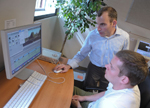Professor Shikha Nangia Named as the Milton and Ann Stevenson Endowed Professor of Biomedical and Chemical Engineering
The College of Engineering and Computer Science (ECS) has announced the appointment of Shikha Nangia as the Milton and Ann Stevenson Endowed Professor of Biomedical and Chemical Engineering. Made possible by a gift from the late Milton and Ann Stevenson,…


 Alan Foley, associate professor in instructional design, development and evaluation, leads the team of researchers that secured the grant. Their individual research projects–in areas including science education, teacher education, instructional technology, linguistics, and communication and rhetorical studies–each pursue questions that necessitate the collection and analysis of large quantities of digital video (DV) data.
Alan Foley, associate professor in instructional design, development and evaluation, leads the team of researchers that secured the grant. Their individual research projects–in areas including science education, teacher education, instructional technology, linguistics, and communication and rhetorical studies–each pursue questions that necessitate the collection and analysis of large quantities of digital video (DV) data.